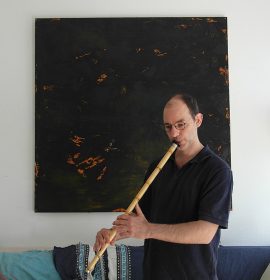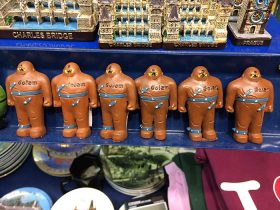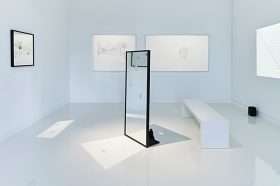They’re ubiquitous in Prague souvenir shops: clunky, mechanical golem figurines that owe their popularity to the 1951 film The Emperor and the Golem. The Czechoslovakian comedy classic, called Císařův pekař a pekařův císař in the original, was conceived by Martin Frič and Jiří Krejčík as a comedy of errors with political undertones. An irascible Emperor Rudolph II and his corrupt court are searching alternately for an elixir of youth and a recipe to turn lead into gold. But above all they want to find the legendary golem. This is the missing piece in the emperor’s cabinet of wonders and curiosities. On the search for the golem a brilliant switch takes place between Rudolf and his imperial baker, Matej. It’s an exchange from which both can profit in their different ways: → continue reading
Bread and Golems
Halftime for (the) GOLEM — What Do Our Visitors Have to Say?
Laura (23), Romania, architecture student
What is your impression of the exhibition?
The exhibition is fascinating and creepy at the same time. It makes you believe that the creatures displayed are real. Therefore, the atmosphere is very intense.
Which object or room has impressed you the most?
The room with the mirrors impressed me a lot. First, we were just playing around, which was fun. I could see myself and my friend in the mirror at the same time. But when I think of it now, it could be a metaphor for “looking beyond yourself.”
Do you know a sort of “Golem” from today?
As children, we have toys, dolls, and sometimes imaginary friends. We can talk to them and make them do what we want them to do.
Edgar (49), Germany, computer science
What was your impression of the exhibition? → continue reading
Painting Music
A Visit with David Benforado

David Benforado playing a nay flute, in the background one of his recent paintings “Brown-Orange,” 150 x 150 cm, oil on linen, 2015/2016; Jewish Museum Berlin, photo: Leonore Maier
“There is a whole world in five notes, just as there is a world in five colors.” With these words David Benforado, painter and musician, expressed his understanding of art to me. Painting Makams and Between Sound and Silence are, appropriately, the titles of his two series for the art vending machine, both of which have been available for sale this year at the Jewish Museum Berlin (more information about the art vending machine on our website). Music and painting are combined in small-scale oils, studies in color filled with energy and vitality.
Ever since David Benforado has been painting, he has been working with music. His atelier has again and again been the site of sessions with professional musicians, for instance during his time in Budapest with the accordion player David Yengiburgan and here in Berlin with pianist Antonis Anissegos. Seven years ago Benforado began studying the ney, a Middle-Eastern flute, and soon he encountered the world of Turkish makams and modal music from the eastern Mediterranean. This became a source of inspiration for his painting. → continue reading

